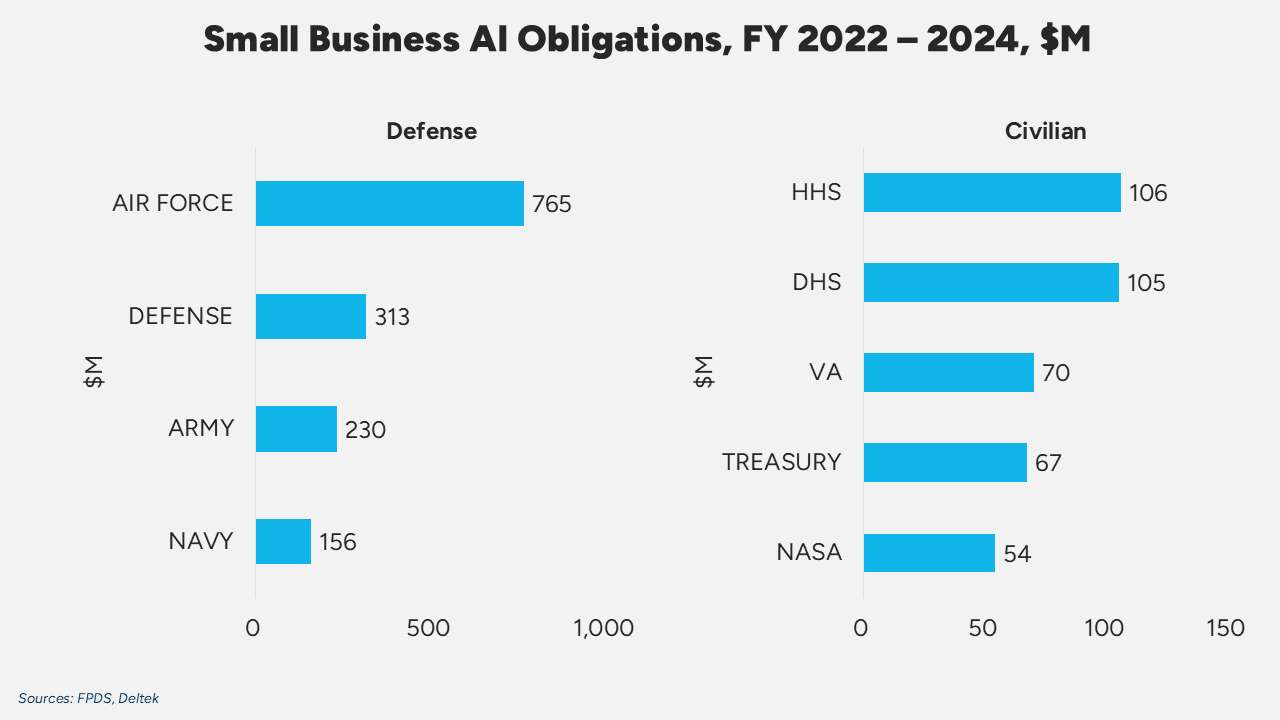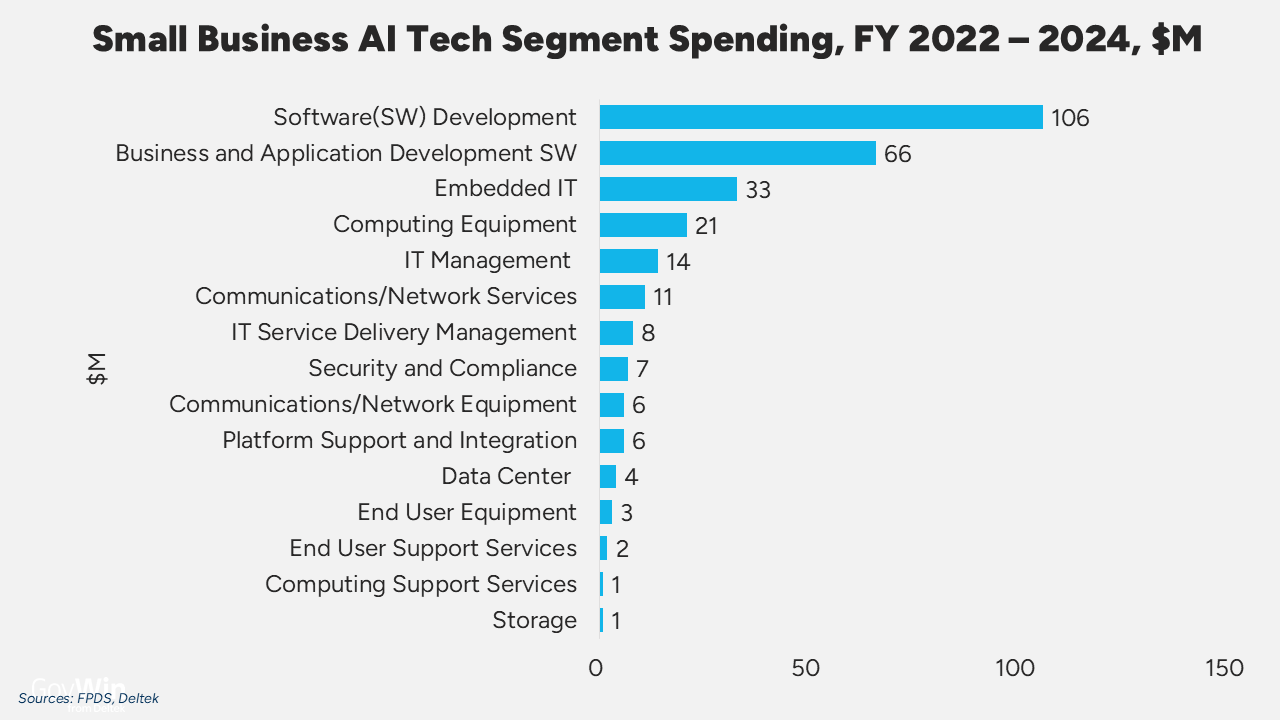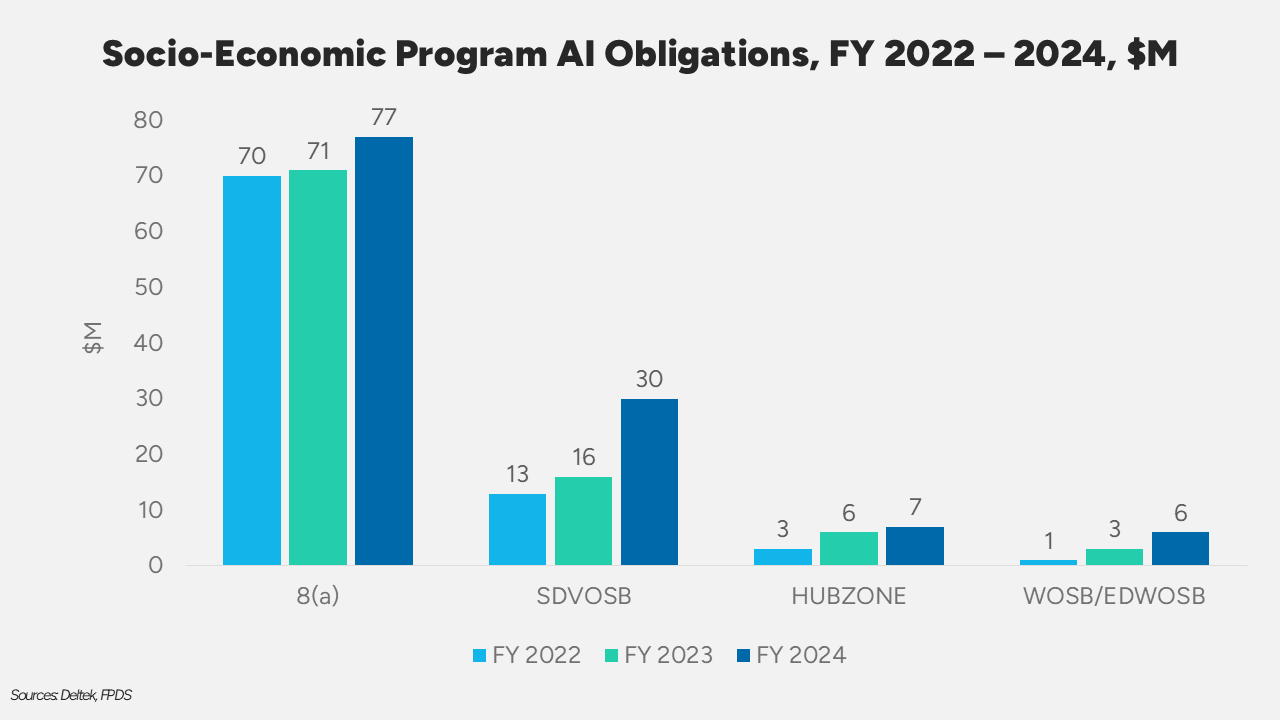Small Business AI Spending FY 2022 - 2024: A Rising Share of Federal Contract Dollars
Published: October 30, 2025
Federal Market AnalysisArtificial Intelligence/Machine LearningSmall Business
Artificial Intelligence (AI) small business investments show steady growth
Small business awards in Artificial Intelligence (AI) over the past three years reflect a 16% annual growth rate, a trend anticipated to continue as federal agencies transition from research and development toward technology scaling.
Federal AI Spending Snapshot
Between FY 2022 and FY 2023, federal agencies awarded $5.6B in prime AI contracts. Small business contracts account for $1.97B, or one-third of total awards, representing a 34% growth during this time. This included $1B awarded under the Small Business Innovative Research (SBIR) and Small Business Technology Transfer (STTR) programs. An additional $22M was awarded in Other Transaction Agreements (OTA).

Key Contract Vehicles
Spending reflects the government’s ongoing emphasis on Category Management, with the top 5 contracts being Government-Wide Acquisition Contracts (GWACs) or Best-in-Class (BIC) vehicles:
- NASA’s Solutions for Enterprisewide Procurement V (SEWP V): $158M
- GSA Consolidated Multiple Award Schedule (MAS): $88M
- Streamlined Technology Acquisition Resources for Services III: $25M
- First Source Information Technology Commodity Solutions II (FirstSource II): $24M
- STARS II: $18M.
Socioeconomic Program Distribution
All four socioeconomic programs sustained growth over the past three years. However, 8(a) firms consistently outpaced awards to Service-Disabled Veteran-Owned Small Business (SDVOSB), Woman-Owned Small Business (WOSB) and Highly Underutilized Business Zone (HUBZone) firms. Certified 8(a) firms received 87% more in contract obligations than the others combined.
The top small business awards include:
- 8(a) three sole source task order awards to International Consulting Associates, Inc., for the Food and Drug Administration’s (FDA) Center for Devices and Radiological Health (CDRH) Medical Diagnostic Equipment (MDE): $17M
- SDVOSB: Robotic Process Automation (RPA): $8M
- WOSB: Marketing and Artificial Intelligence Services for the Coast Guard Recruiting Center: $4M
- HUBZone: UiPath Software Licenses and Maintenance: $3M.
Agency Small Business Spending
Defense small business spending ($1.4B) nearly tripled that of Civilian ($514M), but Civilian growth rates were higher.

Among the top Civilian agencies, Health and Human Services (HHS) and the Department of Homeland Security (DHS) led spending. However, the Department of Agriculture saw the largest growth at 253% - driven by increased investments in AI software and services.
Within Defense, the Air Force led small-business spending with $765M, more than the combined investments among the remaining three agencies. Although the Navy spent the least ($156M), it grew the most with a 652% increase from FY 2022 -2024, driven by software purchases.

Category Focus
Between FY 2022 and 2024, agencies invested more in Research and Development (R&D) spending ($1.1B) than in Information Technology (IT) ($585M), including embedded products and services. However, this is expected to shift as agencies continue integrating AI technologies.

Key Takeaways
Historic AI investments reflect the broad government-wide adoption, increasing the small business share of the market. This trend is expected to continue as agencies continue integrating and scaling technology.
- Defense agencies seek to mature AI for battle-space decision support and logistics.
- Civilian agencies are leveraging the technology for business and process applications.
- Increased IT investments will offset operational impacts from agency reorganizations and staff reductions, creating small-business opportunities.
- Accelerating AI infrastructure development support and streamlining permitting processes for data centers will drive Architecture, Engineering and Construction (AEC) investments.
- Legacy system modernization, ongoing integration and scaling efforts will drive transition to larger IT investments, but R&D will remain a significant market driver.
Challenges
- Reductions in small business opportunities resulting from contract consolidations within the OneGov initiative and increased use of OTAs could reduce the number of small business opportunities
- Understanding and maintaining compliance with the Revolutionary Federal Acquisition Regulation Overhaul (RFO) changes
- Navigating the evolving competitive landscape under revised procurement thresholds and size standards
- Increased contracting officer flexibility in setting procurements aside for small businesses, potentially reducing set-asides under socioeconomic programs.
Recommendations
A thorough understanding of agency directives and requirements by monitoring agency AI use cases will strategically position small businesses to compete for prime and subcontracts over the next three years. Obtaining and leveraging partnerships with firms holding GWACS, BICs, OTAs and Commercial Solution Openings will increase opportunity pipelines. Finally, maintaining regulatory and certification compliance will prevent disqualification from federal competition.
For an in-depth analysis of the Federal AI market, see the Deltek Federal Artificial Intelligence (AI) Market 2026-28 report.
